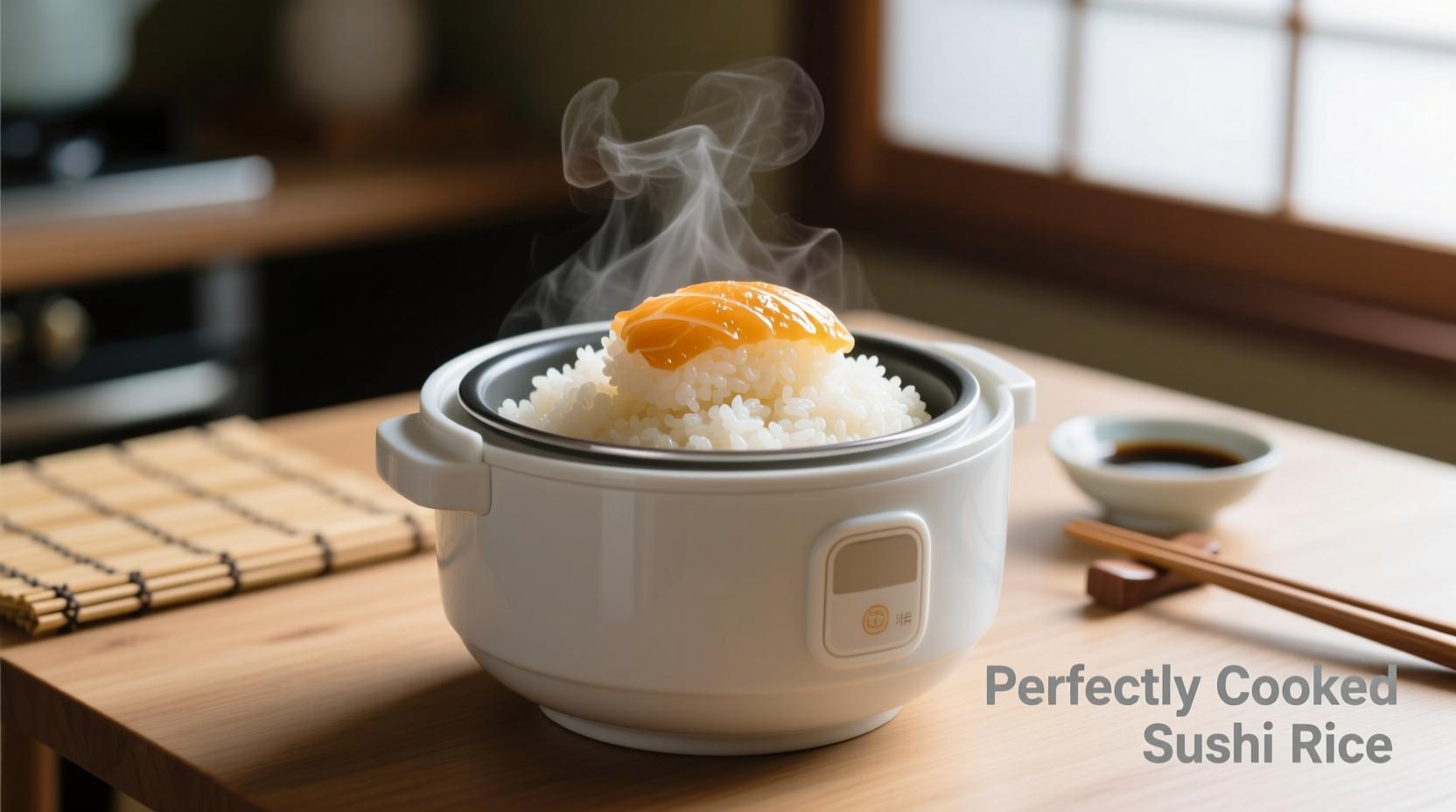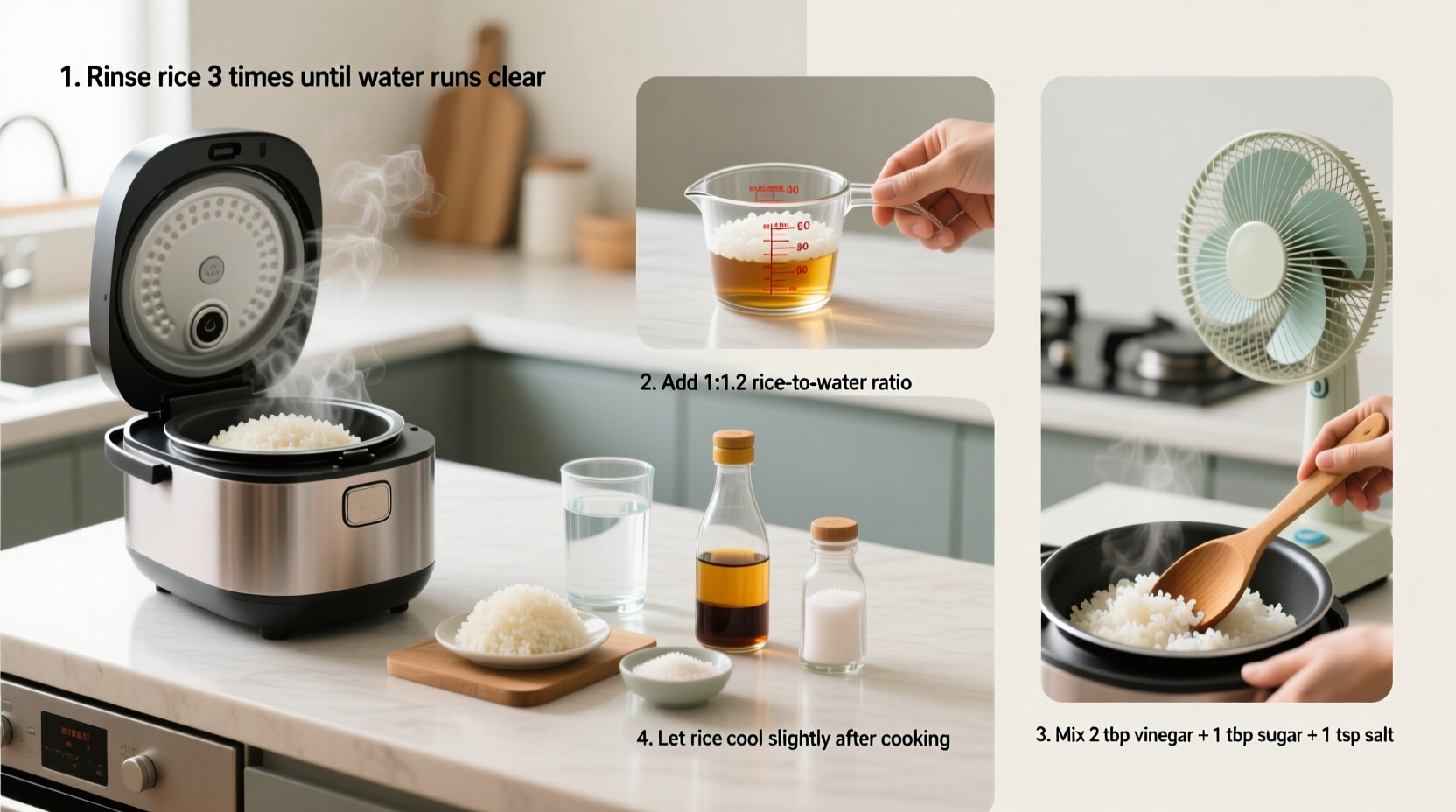The perfect sushi rice recipe for rice cookers requires 2 cups of short-grain Japanese rice, 2 cups of water, and a vinegar mixture of 1/3 cup rice vinegar, 2 tablespoons sugar, and 1 teaspoon salt. Rinse rice 4-5 times until water runs clear, cook in rice cooker, then gently fold in vinegar mixture while cooling. Rest for 10 minutes before use.
Why Your Rice Cooker Is the Secret to Perfect Sushi Rice Every Time
Forget complicated stove-top methods that risk burning or uneven cooking. Using a rice cooker eliminates guesswork while delivering consistently perfect sushi rice with the ideal sticky-yet-separated texture. In just 35 minutes with 5 minutes of active time, you'll have restaurant-quality rice ready for nigiri, maki, or chirashi bowls.
What You'll Actually Need (No Specialty Tools Required)
Many guides overcomplicate sushi rice preparation. You only need these 5 items:
- Standard rice cooker (any brand/model)
- Short-grain Japanese rice (like Koshihikari)
- Rice vinegar (not apple cider or white vinegar)
- Wooden or plastic rice paddle (metal reacts with vinegar)
- Fan or piece of cardboard for cooling
| Ingredient | Traditional Ratio | Rice Cooker Adjustment | Why It Matters |
|---|---|---|---|
| Rice to Water | 1:1.1 | 1:1 | Rice cookers retain more moisture |
| Vinegar Mix | 1:5 (to rice) | 1:5.5 | Compensates for less evaporation |
| Resting Time | 15 min | 10 min | Rice cooks more evenly in sealed environment |
The Step-by-Step Process That Actually Works
Preparation Phase: Where Most Beginners Fail
Washing rice properly is non-negotiable for authentic texture. Place rice in cooker bowl, cover with cold water, and swish gently for 10 seconds. Drain cloudy water. Repeat 4-5 times until water is slightly hazy but not milky. This removes excess starch that causes gummy texture.
Soaking time varies by rice cooker type:
- Basic models: Soak 30 minutes after washing (critical for even absorption)
- Premium models: Skip soaking (advanced sensors compensate)
- Older models: Soak 45 minutes (compensates for weaker heating)
Cooking Phase: The Critical Water Ratio
Add exactly 2 cups water to 2 cups washed rice. Do not skip the finger test: place index finger on rice surface - water should reach first knuckle line. Press 'white rice' setting (not 'sushi' if available - those settings often overcook).
During cooking, resist the urge to peek! Opening the lid releases steam needed for proper gelatinization of starches. The entire cooking cycle should take 25-30 minutes depending on your model.

Cooling Phase: Where Texture Is Made
Immediately after cooking cycle ends, transfer rice to a wooden hangiri (or non-reactive bowl). While rice is still hot, gently fold in vinegar mixture using slicing motions - never stir. Fan vigorously for 2 minutes while folding to achieve glossy finish and proper temperature (body temperature is ideal for sushi assembly).
Rest covered with damp cloth for 10 minutes. This allows vinegar to fully absorb while maintaining ideal stickiness. Never skip this step - premature use causes rice to fall apart in rolls.
Troubleshooting Your Sushi Rice (Real Solutions)
Even with a rice cooker, issues happen. Here's how to fix them:
If Rice Is Too Sticky
Cause: Insufficient rinsing or too much water
Solution: Next time, rinse 1-2 additional times and reduce water by 2 tablespoons. For current batch, gently separate grains with damp fingers while cooling.
If Rice Is Too Dry
Cause: Over-rinsing or old rice
Solution: Add 1-2 teaspoons warm water while folding vinegar mixture. Store unused rice with damp paper towel on surface.
If Rice Tastes Sour
Cause: Vinegar mixture added to cooled rice
Solution: Always add mixture while rice is hot (140°F/60°C minimum). The heat helps evaporate harsh vinegar notes while absorbing sweetness.
When NOT to Use a Rice Cooker for Sushi Rice
While convenient, rice cookers have limitations. Avoid this method when:
- Using aged rice (over 6 months storage) - requires more water than cookers can handle
- Making large batches (over 4 cups raw rice) - uneven cooking occurs
- Using non-Japanese short-grain rice - different starch content requires stove-top control
For competition-level sushi or traditional omakase preparation, professional chefs still prefer the hagama (cast iron pot) method for ultimate texture control. But for home cooks and casual sushi nights, the rice cooker delivers 95% of the quality with half the effort.
Pro Tips from Sushi Masters
- Temperature matters: Rice should be body temperature (98.6°F/37°C) when shaping - use an instant-read thermometer
- Vinegar secret: Warm vinegar mixture slightly before adding - cold vinegar shocks the rice
- Moisture control: Cover resting rice with otoshibuta (drop lid) or damp cloth to prevent drying
- Leftover magic: Refrigerated sushi rice makes excellent chazuke (tea over rice) the next day











 浙公网安备
33010002000092号
浙公网安备
33010002000092号 浙B2-20120091-4
浙B2-20120091-4